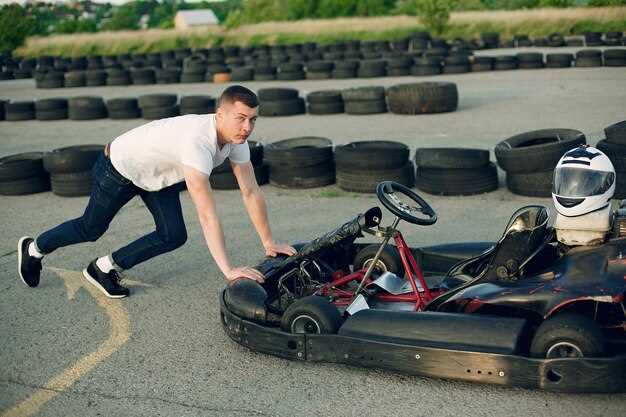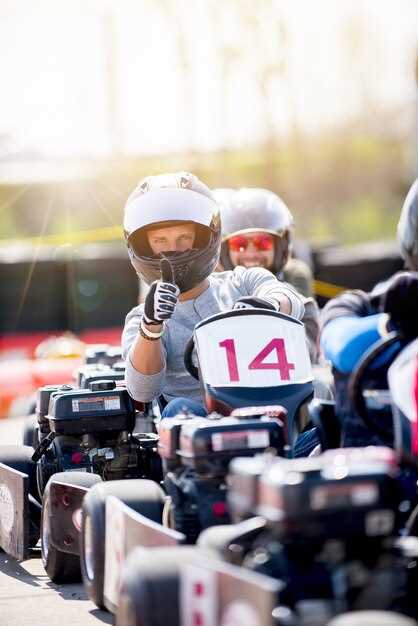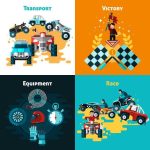You should consider a structured training program designed specifically for young drivers looking to excel in motorsport. These programs not only focus on driving techniques but also encompass physical fitness, mental resilience, and tactical skills. Engaging in a multifaceted training regimen prepares aspiring racers for the intense demands of competitive racing.
Incorporating driving simulators into training significantly enhances skills like reaction time and race strategy. Many training centers utilize advanced simulators that mimic real-world racing scenarios, giving young drivers a safe environment to refine their abilities. Pair this with regular on-track training sessions and physical conditioning, which is key for maintaining stamina and focus during races.
Finding a program that offers mentorship from experienced drivers can provide valuable insights. These mentors can share their knowledge about track techniques, racecraft, and off-track strategies, honing the young driver’s racing acumen. Combining both practical and theoretical learning experiences accelerates skill development and boosts confidence on the track.
Finally, participating in local racing events allows young drivers to apply their training in real competitive environments. These events not only help in understanding the dynamics of racing but also in building a network with other racers and industry professionals. Through consistent practice and guidance, young drivers will be better equipped to pursue their motorsport careers with dedication and talent.
Understanding the Basics of Motorsport Training

Focus on physical fitness and mental conditioning to enhance driving skills. Drivers must build endurance, strength, and flexibility through targeted exercises. Incorporating cardio workouts like running and cycling improves stamina, while strength training sessions using weights develop the necessary muscle control.
Key Components of Training
- Technical Skills: Spend time honing vehicle control, cornering techniques, and braking efficiency. Utilize simulators and practice on closed circuits to develop precision.
- Racecraft: Learn about race strategies, including overtaking maneuvers and defensive driving. Study race scenarios to anticipate competitors’ moves.
- Vehicle Knowledge: Understand how different vehicles operate, including various handling characteristics and mechanics. This knowledge aids in making informed decisions during a race.
- Mental Resilience: Train your mind to handle pressure, focus on goals, and maintain composure in high-stress situations. Visualization techniques can enhance performance and confidence.
Regular Practice and Feedback
Consistent practice is key. Schedule track days regularly, and seek feedback from experienced coaches. Analyze video footage of your driving to identify areas for improvement. Constructive criticism sharpens skills and develops a growth mindset.
Engaging with fellow drivers fosters a collaborative learning environment. Sharing experiences and tips strengthens community ties while enhancing personal development.
Set clear goals and track progress over time. This approach helps maintain motivation and aligns training efforts with aspirations. Celebrate small achievements along the way to keep enthusiasm high.
Selecting the Right Racing Simulator for Beginners

Choose a racing simulator that fits both your budget and skill level. Look for platforms like iRacing or Assetto Corsa, which offer beginner-friendly options. These simulators provide realistic driving physics and a wide range of vehicles, making them ideal for learning.
Consider the equipment you’ll need. A reliable steering wheel and pedals enhance the experience. Brands like Logitech and Thrustmaster offer affordable yet effective setups for newcomers. Look for direct drive or force feedback options as you advance.
Check for available tutorials and community support. Simulators with strong online communities, like rFactor, allow for shared tips and advice, helping you learn faster and stay motivated.
Experiment with different cars and tracks to identify what suits your driving style. Many simulators offer practice modes. Make the most of these features to build confidence and improve your skills.
Don’t forget to tweak the settings. Adjust your graphics and controls for better performance on your device. A comfortable setup can make a significant difference in your racing experience.
Finally, enjoy the process. Racing simulators provide a fun way to develop your skills and prepare for real-life driving. Keep this perspective, and you’ll find your learning path much more enjoyable.
Key Components of a Successful Driver Training Program

A robust driver training program integrates several key components that significantly enhance young drivers’ skills and knowledge.
- Structured Curriculum: Develop a curriculum that covers both theoretical and practical aspects of driving. Include modules on vehicle dynamics, racing lines, and track tactics.
- Experienced Instructors: Enlist qualified instructors with extensive experience in motorsport. Personal mentoring from professionals helps trainees grasp advanced techniques more effectively.
- Simulated Environments: Utilize driving simulators to provide young drivers with a safe space to practice high-pressure situations and various track conditions without the risks of real-world racing.
- Regular Track Sessions: Schedule consistent on-track sessions to reinforce skills learned in the classroom. Regular practice solidifies technique and builds confidence.
- Performance Analysis: Implement systems to analyze performance data from training sessions. Use telemetry and video feedback to help drivers understand their strengths and areas for improvement.
- Physical Fitness Training: Incorporate physical conditioning into the program. Enhanced fitness levels improve endurance and focus, essential for performance in competitive environments.
- Mental Preparedness: Address mental strategies for handling pressure and developing racecraft. Workshops on mental resilience and focus techniques empower young drivers to perform their best.
- Safety Protocols: Educate drivers on safety measures, including proper use of safety gear and emergency response protocols. Encourage a culture of safety both on and off the track.
- Circuit Familiarization: Familiarize trainees with various tracks and layouts through guided tours and visual aids. Understanding the characteristics of each track enhances race strategy.
Integrating these components ensures young drivers receive a well-rounded training experience that prepares them for the challenges of motorsport.
The Role of Physical Fitness in Motorsport Performance
Young drivers should focus on strength training, cardiovascular fitness, and flexibility to enhance their performance on the track. Strength training, especially core stability exercises, helps maintain control during high-speed maneuvers. Incorporating exercises like planks, squats, and deadlifts develops essential muscle groups used in racing.
Cardiovascular fitness is equally crucial. A well-conditioned cardiovascular system enables drivers to remain alert and focused for extended periods. Activities such as running, cycling, or swimming build endurance. Aim for at least 30 minutes of aerobic exercise three times a week to support prolonged concentration during races.
Flexibility plays a significant role in preventing injuries and ensuring drivers can comfortably maneuver in their seats. Regular stretching routines, including dynamic stretches before workouts and static stretching afterward, enhance range of motion and reduce muscle tension. Incorporate yoga sessions weekly to improve overall flexibility and promote relaxation.
| Fitness Component | Recommended Activities | Frequency |
|---|---|---|
| Strength Training | Planks, squats, deadlifts | 3 times per week |
| Cardiovascular Fitness | Running, cycling, swimming | 3 times per week |
| Flexibility | Dynamic stretching, yoga | Weekly sessions |
Finally, mental fitness complements physical preparation. Practicing visualization techniques helps young drivers prepare for various race scenarios. Mindfulness exercises can enhance focus and reduce anxiety, leading to improved performance under pressure. Combining these elements creates a holistic training program that empowers young drivers to excel in motorsport.
Developing Mental Resilience in Young Drivers
Encourage young drivers to practice visualization techniques regularly. Before each race or practice session, they should take a few moments to mentally rehearse their performance. Visualizing each turn, the sound of the engine, and the feel of the car under different conditions prepares them for real scenarios, building their confidence.
Introduce mindfulness practices. Simple breathing exercises can significantly reduce anxiety and enhance focus. Teach them to take deep, deliberate breaths in high-pressure situations. A calm mind improves decision-making and reaction times on the track.
Incorporate simulated pressure situations during training. Create scenarios that mimic real race conditions, such as adverse weather or unexpected obstacles. This exposure helps young drivers develop coping strategies for stress and build their ability to remain composed during challenging situations.
Encourage reflective practice. After each session, have young drivers assess their performance. Ask them to identify what went well and what could be improved. This process fosters a growth mindset, allowing them to view setbacks as opportunities for learning rather than failures.
Promote a supportive environment. Having a team that offers constructive feedback and encouragement boosts a driver’s resilience. Recognize their efforts and progress, regardless of outcomes. A positive atmosphere strengthens their mental toughness and willingness to push through challenges.
Teach goal-setting techniques. Help young drivers set specific, measurable, achievable, relevant, and time-bound (SMART) goals. Breaking down larger objectives into smaller milestones creates a sense of accomplishment and reinforces their commitment to improvement.
Use competitive team activities to build camaraderie. Engaging with peers creates a sense of belonging and shared purpose. Working together strengthens emotional support networks and helps young drivers manage stress through social connectivity.
Analyzing Data from Racing Simulators to Improve Skills
Utilize telemetry data to track your performance metrics. Focus on lap times, acceleration profiles, braking points, and cornering speeds. This information reveals where you excel and where improvements are needed. For example, if your braking points are inconsistent, adjust your approach based on the data to find optimal braking distances.
Identifying Patterns and Trends
Regularly review lap data to identify patterns over time. Compare your lap times, looking for trends in performance. If a specific corner consistently slows you down, analyze the data to pinpoint why. Is it a matter of steering angle, throttle control, or another factor? Adjust your driving style accordingly.
Simulating Real-World Conditions
Use racing simulators to replicate real-world conditions. Adjust weather settings, tire wear, and fuel loads to simulate race scenarios. Monitor how these changes impact your driving. By analyzing data under various conditions, you’ll become more adaptable, preparing you for actual races.
Utilize onboard cameras or streaming features to capture your racing sessions. Combine video analysis with your telemetry data for a comprehensive review. Observing your driving style alongside hard data can uncover insights that numbers alone might miss, guiding you toward more precise driving techniques.
Engage with online communities that share performance data and analysis. Collaborating with others can provide fresh perspectives and new strategies. Sharing experiences helps everyone improve and fosters a knowledgeable network of young drivers.
Focus on continual learning; every session provides data to analyze. Track improvements over time, adjusting your training methods based on findings. This analytical approach will systematically enhance your driving skills, accelerating your development as a competitive racer.
Identifying Safe and Effective Training Environments
Choose training locations with controlled conditions that minimize risks. Look for venues specifically designed for motorsport training, such as purpose-built racetracks and off-road courses. These sites often feature safety barriers, runoff areas, and medical assistance readily available.
Conduct thorough research on the training facility’s safety protocols. Ensure they provide proper briefing sessions, gear checks, and first-aid kits. The presence of experienced instructors enhances the learning experience, as they guide young drivers through both theoretical and practical aspects of racing.
Include variety in training environments. Each type, from karting tracks to dirt courses, helps drivers develop a wide range of skills. Here’s a breakdown of useful environments:
- Closed Circuit Tracks: Ideal for honing speed and precision. Multiple configurations allow for different techniques and strategies.
- Off-Road Terrain: Encourages adaptability and control in unpredictable situations, which is vital for young drivers.
- Simulators: Create scenarios that may be impractical or unsafe in real life. They prepare drivers for diverse conditions without physical risk.
Evaluate facility maintenance. Regular inspections and updates to equipment and safety features indicate a priority on safety. Ask for feedback from previous participants to understand their experiences and the facility’s reliability.
Incorporate both group and individual training sessions. Group dynamics can foster peer learning and motivate participants. Individual attention helps address specific weaknesses, ensuring balanced skill development.
Finally, establish clear communication between instructors and young drivers. Open dialogue helps identify concerns and enhances the ability to adapt training methods when needed. This supportive environment promotes confidence and skill mastery quickly.
Building a Support Network for Aspiring Young Drivers
Creating a robust support network is key for young drivers aiming to excel in motorsport. Connect with local racing clubs and organizations; these groups often offer resources, mentorship opportunities, and access to fellow racers. Establish relationships with experienced drivers who can provide insights into their experiences and challenges, helping your development on and off the track.
Engage with Coaches and Trainers
Seek out coaches who specialize in motorsport. A qualified coach tailors training programs and provides constructive feedback, enhancing skills and strategies. Regular sessions improve technique and prepare for competitive environments. Engage coaches through open communication about goals and aspirations to build a strong rapport, ensuring they understand individual needs.
Leverage Social Media and Online Communities
Utilize social media platforms to connect with other aspiring drivers and professionals in the industry. Joining online forums and groups can lead to networking opportunities, sharing of experiences, and advice. Actively participate in discussions, showcasing your interest and commitment, which can attract potential sponsors or partnerships. Consistently reach out and engage with influential figures in motorsport, as these connections can elevate visibility and create further opportunities.
Finding Qualified Coaches and Mentors in Motorsport
Seek out certified coaches with recognized credentials from motorsport associations such as the FIA or SCCA. Verify their experience through interviews and references. Look for coaches who have competed at high levels, as they offer valuable insights beyond theoretical knowledge.
Utilize Networking Opportunities
Attend motorsport events, seminars, and workshops to connect with potential coaches. Engage with industry professionals on social media platforms like LinkedIn and Twitter. Consider joining local racing clubs or organizations to expand your network and gain recommendations for reputable mentors.
Assess Compatibility and Coaching Style
Conduct trial sessions with prospective coaches to evaluate their teaching methods and compatibility with your learning style. Effective communication and a supportive approach can significantly enhance your training experience. Ensure they can tailor their coaching to your specific goals and needs.
Utilizing Video Analysis for Performance Enhancement
Incorporate video analysis into your training to pinpoint strengths and weaknesses. Recording practice sessions allows for review of driving techniques, enabling drivers to see their performance from an external perspective. This method highlights areas needing improvement, such as braking points, cornering techniques, and throttle application.
Utilize high-definition cameras to capture various angles during track runs. Cameras placed inside the cockpit provide insight into steering inputs and pedal work, while outside views reveal overall line choice and speed. Use software to overlay telemetry data on video, allowing drivers to correlate visual feedback with performance metrics like cornering speed and G-forces.
Establish a systematic approach to video review. Schedule sessions after each practice to analyze recordings alongside a coach. Focus on specific maneuvers during these reviews and create actionable objectives for the next session. For instance, if you notice inconsistent cornering speeds, set a goal to improve entry and exit techniques.
| Focus Area | Video Analysis Technique | Goal Setting |
|---|---|---|
| Braking | Review brake transition points from multiple angles | Aim for consistent braking zones |
| Corners | Identify apex points using side footage | Maximize corner speed |
| Throttle Control | Analyze pedal application during acceleration | Improve exit speeds |
Track improvement by comparing video from different sessions. Such comparisons create a tangible measure of progress and motivate drivers. Consider setting up a video library for archiving sessions over time, which aids in reviewing long-term development.
Integrating video analysis establishes a clearer road for young drivers aspiring for greatness. This method not only enhances performance but builds critical thinking and self-awareness in driving skills.
Setting Realistic Goals for Motorsport Aspirants
Your first step is to identify your current skill level. Assess where you stand in terms of driving skills, karting experience, or any related activities. Based on this evaluation, outline specific areas you wish to improve. For instance, if you’re shaky in cornering techniques, prioritize practice sessions that focus on this skill.
Next, break down your long-term ambitions into manageable short-term goals. Rather than aiming to win a championship right away, target smaller milestones like completing a specific number of laps, improving lap times, or mastering driving lines. Progressing gradually helps build confidence and skill simultaneously.
Creating a Training Schedule
A structured training schedule keeps you accountable. Allocate regular times for practice, and incorporate a mix of on-track sessions and simulator training. Use this time to refine techniques and receive feedback from coaches or mentors. Consistency is key; commit to your schedule and track improvements over time.
Staying Adaptable
Stay flexible with your goals. Assess your progress regularly and adjust your targets as needed. If you encounter challenges, refine your approach rather than feeling discouraged. Celebrate small achievements along the way, as these moments contribute significantly to your overall development in motorsport.
Video:
How to Start a Career in Motorsports
How to Start a Career in Motorsports by Grassroots Motorsports 6,877 views 2 years ago 20 minutes
Q&A:
What are the main components of motorsport training programs for young drivers?
Motorsport training programs for young drivers typically include several key components. First, there is a strong focus on technical skills, where drivers learn about vehicle dynamics, handling, and the mechanics of the cars they will be racing. This helps them understand how to optimize their performance on the track. Secondly, physical fitness is emphasized, as racing requires considerable strength, stamina, and agility. Nutrition and mental conditioning also play important roles, helping drivers maintain peak performance under pressure. Finally, practical experience in the form of on-track training and simulation sessions is crucial, allowing young drivers to apply what they’ve learned in real-world scenarios.
How do these training programs cater to different skill levels among young drivers?
Training programs are designed to accommodate a variety of skill levels among young drivers by offering tailored instruction and progression tracks. Beginners often start with fundamental techniques and safety protocols, gradually being introduced to more complex driving skills and strategies. Intermediate drivers might focus on race craft, which includes tactics specific to competitive driving, while advanced drivers can work on fine-tuning their performance and developing a personal racing style. By employing a mix of classroom instruction, simulator use, and on-track practice, programs ensure that each participant can build on their existing abilities and reach their potential.
How do motorsport training programs address safety for young drivers?
Safety is a paramount concern in motorsport training programs for young drivers. These programs begin by instilling a strong understanding of safe driving practices and the importance of wearing proper safety gear, including helmets and fire-resistant suits. Instructors teach drivers about the risks involved in racing and how to manage them effectively. Additionally, training sessions often include scenarios that simulate potential hazards on the track, allowing drivers to practice safe responses. Programs may also cover vehicle safety checks and maintenance to ensure that cars are in optimal condition before hitting the track. By prioritizing safety at every stage, training programs help prepare young drivers to compete responsibly.
What role does mental training play in the development of young motorsport drivers?
Mental training is a critical component of developing young motorsport drivers, as racing involves not only physical skill but also mental acuity. Programs often include techniques such as visualization, where drivers imagine themselves successfully completing a race or executing specific maneuvers. This can enhance focus and confidence during actual races. Additionally, mental conditioning exercises help drivers manage stress and anxiety, enabling them to remain calm under pressure. Working with sports psychologists is common, and these experts provide strategies for maintaining a competitive mindset, handling setbacks, and boosting resilience. By addressing the psychological aspects of racing, programs help young drivers become more well-rounded competitors.


